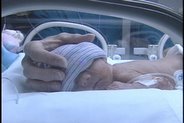An excellent study of technology designed to eradicate MRSA is found in a recent issue of the Journal of Hospital Infection. Researchers assessed the short and long term effects of cleaning a hospital ward with Hydrogen Peroxide Vapor (HPV). Due to its oxidative properties, hydrogen peroxide is effective at eliminating many types of bacteria.
 During the five month study, researchers measured MRSA contamination for the three months prior, and four weeks after an ICU was cleaned using HPV. Scientists used a machine like this one to create the vapor that was released inside the sealed, nine bed ICU. Previous studies have noted that HPV is considered a ‘big gun’ in disinfection, affording significant reduction of bacteria when combined with surface cleaning.
During the five month study, researchers measured MRSA contamination for the three months prior, and four weeks after an ICU was cleaned using HPV. Scientists used a machine like this one to create the vapor that was released inside the sealed, nine bed ICU. Previous studies have noted that HPV is considered a ‘big gun’ in disinfection, affording significant reduction of bacteria when combined with surface cleaning.
In the months prior to the HPV treatment, MRSA was isolated from 11.2% of sample sites. In the hours immediately following the HPV, no MRSA was isolated from the environment. The HPV did its job, end of story. Not quite.
The researchers wanted to look for MRSA after the HPV treatment, when real patients populated the ward. In less than 24 hours, the MRSA was back in the ICU:
“Twenty-four hours after the readmission of patients, MRSA was isolated from five environmental sites. All of the strains were indistinguishable from the strain with which the patient in bed space 8 was colonized, but the environmental contamination was not confined within that bed space.”
Despite the effectiveness of the ‘big guns’ (HPV), MRSA returned. In fact, detected MRSA surpassed the pre-HPV levels (11.2% v. 16.3%). Use of HPV is a great idea, but it cannot be the Infection Control Practitioner’s only weapon. Disinfection is an ongoing battle fought everyday, in every ward. Vigilance and multi-faceted approaches are the keys to long term success.
VIGILAIR® can be an important part of that strategy. Deployed within the Hospital’s air handlers, VIGILAIR® constantly disinfects the air through a combination of ultraviolet germicidal irradiation (UVGI) and high efficiency filtration. The technology is more than infection control, it is infection prevention.
As we always say, there is no panacea in the fight against MRSA, H5N1 and HAI. There needs to be a cross-discipline, evidence based strategy to identify, and eradicate all pathogen reservoirs within a hospital. With changes looming on the reimbursement horizon, this strategy will keep patients and hospitals healthy.
A white paper on airborne pathogens is available here.
Original Study:
K.J. Hardy, et al. Rapid recontamination with MRSA of the environment of an intensive care unit after decontamination with hydrogen peroxide vapour. Journal of Hospital Infection (2007) 66, 360-368
Image:


